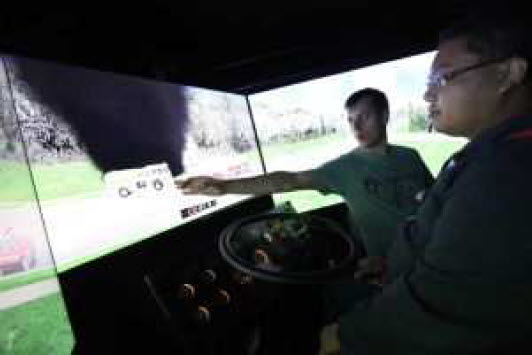Newsday
Nassau emergency service providers use driving simulators to train
October 31, 2013 by JENNIFER BARRIOS / jennifer.barrios@newsday.com
Four Nassau County fire departments have joined a growing number of emergency service providers on Long Island that use computerized driving simulators to train firefighters, paramedics and police officers in safely driving to emergencies. The simulators — which feature actual car and truck seats, complete with seat belts and realistic dashboards surrounded by three large computer monitors that display virtual streets — aren’t meant to replace actual time on the road, officials say. But they can allow drivers to experience making instantaneous decisions — and mistakes — as they respond to virtual emergencies, without the concerns about real-life crashes. “Here, if you make a mistake, you’re not playing for keeps,” said Lt. Pat Cooke of the Hempstead Village Police Department, which purchased a simulator last year. “It’s a safe way to put you into dangerous situations.”
Last month, four agencies — the Manhasset-Lakeville Fire District and the Great Neck Alert, Great Neck Vigilant and Albertson fire companies — received a driving simulator purchased with a $285,920 grant, written by East Williston grant-writing company JSK Inc., from the Federal Emergency Management Agency Assistance to Firefighters Grant Program. The simulator, housed in a black trailer, includes two driving stations — one with a Ford Crown Victoria dashboard, suitable for replicating a chief’s SUV or ambulance, and another that simulates fire apparatus such as a pumper truck or tower ladder — as well as a dispatch station that controls what appears before each driver. Eight firefighters and EMTs from the four departments crammed into the trailer one recent evening, learning to train their colleagues on the equipment. Jason Lasek, assistant chief of the Albertson Fire Company, stood by, holding a cup of coffee as Albertson firefighter Neil Velasco sat in the engine simulator, maneuvering a tower ladder to the scene of a virtual fire, lights and sirens blaring. “Second-floor smoke — occupant possibly trapped at this time,” Lasek called out, as Velasco edged out into virtual intersections that featured computerized tractor trailers that barely stopped and school buses that discharged oblivious students into the street. “When I started driving, you went on the rig and started driving around town,” Velasco, 32, said later. “You’re experiencing a lot of the things for the first time the first time out. This allows you to experience it the first time here.”
Benefit seen in technology – Lasek, 31, thought the technology would especially help younger recruits. “The natural adrenaline rush — this helps you work with that in a safe environment,” he said. Vehicle collisions were the second-leading cause of death for firefighters in 2012, and for police officers over the last decade. A 2002 study found that ground transportation was the No. 1 cause of fatalities for emergency medical services personnel. The National Fire Protection Association considers simulators a useful adjunct to driver training, not a replacement for being in the actual vehicle, said Kenneth R. Willette, division manager of public fire protection at the Massachusetts-based organization. But, he said, “the more times an apparatus operator trains, using the simulator or hands-on, the safer and more proficient that operator will be.”
Doctor addresses problems
Not everyone is convinced. Dr. Nadine Levick, who founded the EMS Safety Foundation in Manhattan, said that simulators make sense for pilots training on jet planes, not for emergency personnel who drive ambulances and fire engines. “The problems relate to distractions and exhaustion and all these things the simulator can’t fix,” Levick said, noting that simulators can cause motion sickness in users. About half of Hempstead Village’s police force has gone through training on that department’s simulator, set up to replicate the agency’s patrol cars down to the placement of siren switches.
“What simulators basically do is allow you the ability to make decisions,” Cooke said. “You’re doing 60 [mph] down the block and there are cars coming in each direction and you have to safely clear the intersection. Or you’re responding to the emergency situation, lights and sirens, and you have to get through traffic. What do you do?” He said many of the officers who scoff at the idea of a simulator being useful leave with a
renewed appreciation for the device. “Some people come in with preconceived notions that it’s a video game, it’s not going to help me,” Cooke said. “By the time they leave, they’re into it.” The North Shore-Long Island Jewish Health System has had a driving simulator for its emergency medical personnel since May, purchased with a $226,000 grant from the Queens Borough president’s office, said Alan Schwalberg, vice president of the Center for Emergency Medical Services there. So far, North Shore-LIJ has trained about half of its roughly 500 emergency medical technicians and paramedics on the simulator, housed in a box truck. “We’re not trying to teach them how to drive,” Schwalberg said. “We’re trying to teach them situational awareness — what other drivers are going to do, what the road conditions are. This is the importance of this type of training.”

0 Comments